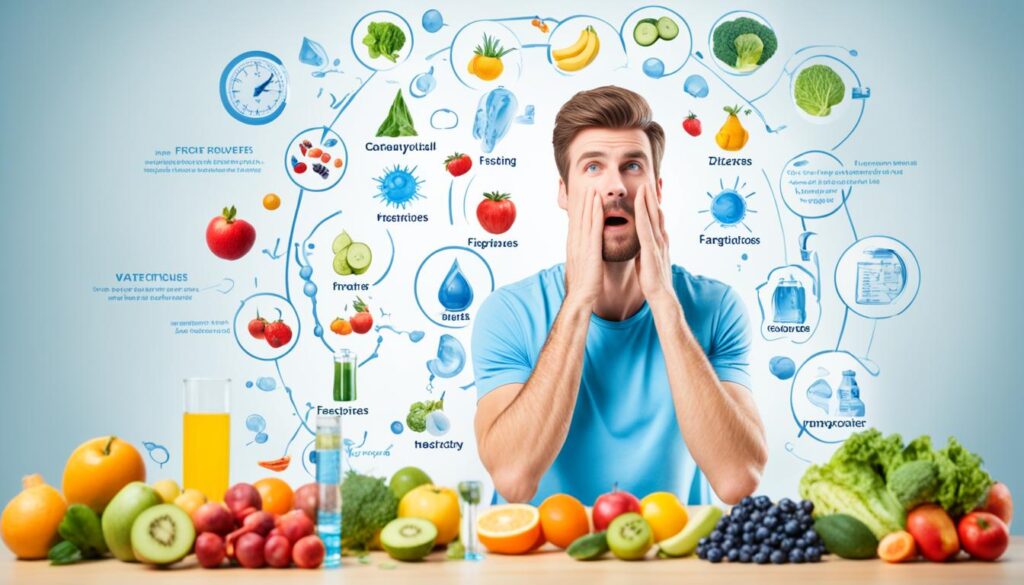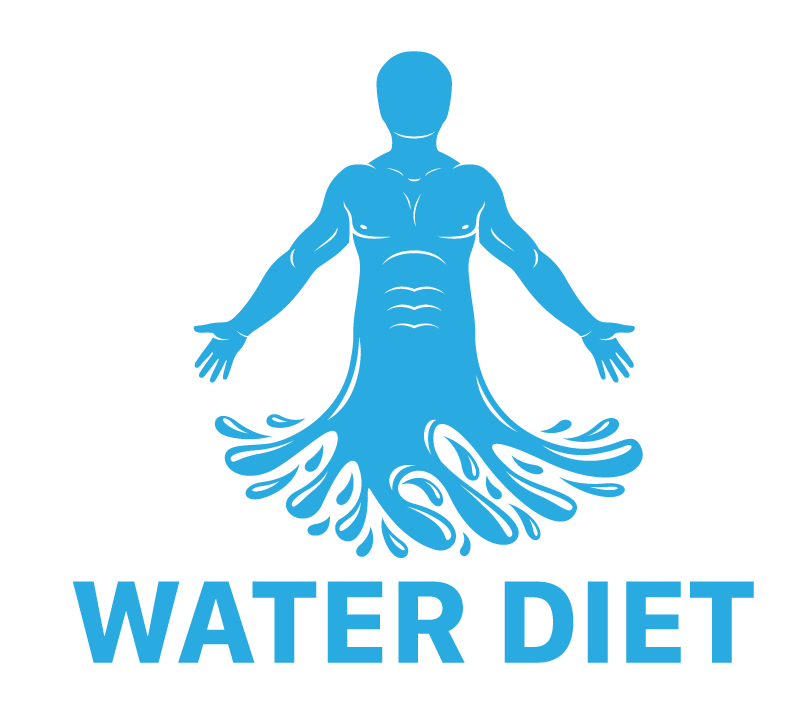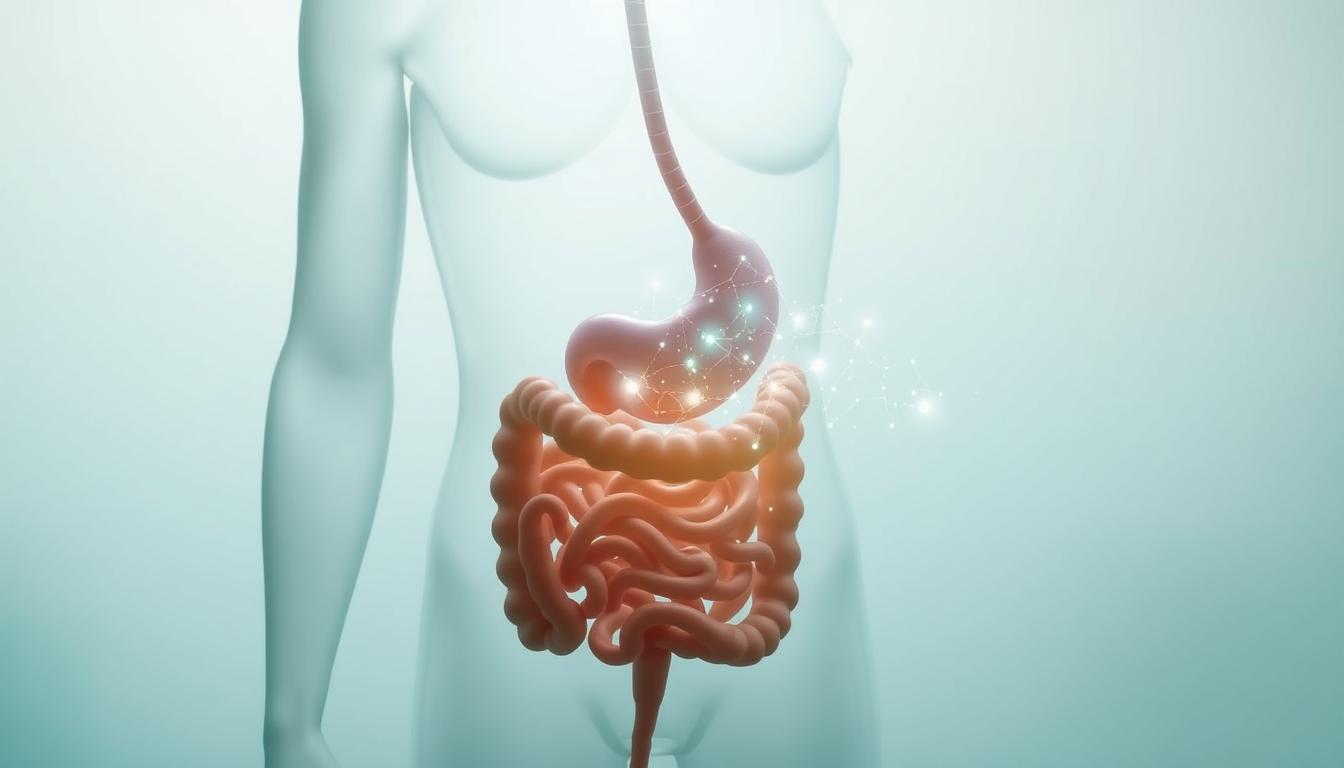Water fasting is getting more popular for health, weight loss, or detox. But, ending a water fast right is key. Jumping back into eating can upset your stomach and be risky for your health. Follow these tips to smoothly go back to eating solid foods and keep the fasting benefits.
When ending a water fast, focus on getting back your fluids and electrolytes. Start with small amounts of water or herbal tea, then slowly drink more as the day goes on. Adding drinks with lots of electrolytes, like coconut water or bone broth, helps replace lost minerals.
When you start eating solid foods again, pick soft, nutrient-rich foods. Soft fruits, steamed veggies, and light soups are great for your first meals. Eating small amounts and chewing well helps your stomach adjust to solid foods.
Key Takeaways
- Break your water fast gradually, starting with easily digestible liquids and soft foods.
- Prioritize hydration and electrolyte replenishment by sipping on water, herbal tea, and electrolyte-rich beverages.
- Choose nutrient-dense, easily digestible foods like soft fruits, steamed vegetables, and light soups for your first post-fast meals.
- Start with small portions and chew thoroughly to help your digestive system readjust.
- Listen to your body’s signals and adjust your eating plan as needed to avoid digestive distress.
Understanding the Importance of Breaking a Water Fast Properly
After a water fast, it’s key to break the fast safely. Jumping back into eating too quickly can upset your stomach. Your body changes when you fast, and your digestive system rests. Slowly adding solid foods helps your body adjust and prevents problems.
Why Your Digestive System Needs Time to Readjust
A water fast gives your digestive system a break. It stops digesting and absorbing food. This helps your body focus on cleaning and fixing cells. But, your digestive system needs time to start again when you stop fasting.
Eating too much or hard foods right after can cause stomach issues like bloating and diarrhea. Your digestive enzymes and gut bacteria might be low. Slowly adding foods helps your digestive system adjust, reducing side effects and making the transition back to normal eating easier.
The Risks of Refeeding Syndrome
Refeeding syndrome is a serious issue from eating too much too fast after fasting or not eating enough. This can upset your body’s balance of fluids and electrolytes, causing big problems.
When fasting, your body uses up glycogen and breaks down fat and muscle for energy. Then, eating again makes your body release insulin to process the food. This can move electrolytes like phosphate, potassium, and magnesium into your cells too fast. This can cause muscle weakness, confusion, seizures, and even heart failure.
| Risk Factors for Refeeding Syndrome | Potential Complications |
|---|---|
| Prolonged fasting (>5 days) | Electrolyte imbalances |
| Low body weight (BMI <18.5) | Cardiac arrhythmias |
| Rapid weight loss | Respiratory failure |
| History of malnutrition | Neurological complications |
To avoid refeeding syndrome, break your fast slowly and with a doctor’s help, especially if you’ve fasted for a long time or have health issues. Watching how your body reacts and adjusting your food can help you safely go back to eating normally. This way, you can avoid the dangers of refeeding syndrome.
Choosing the Best Foods to Break a Water Fast
When you end a water fast, picking foods that are easy on your stomach, full of nutrients, and low in carbs is key. These foods help your body get used to eating solid foods again. They also give you the nutrients and electrolytes you need.
Gentle, Easily Digestible Options
Your digestive system needs time to adjust after fasting. Choosing foods that are easy to digest can prevent stomach upset. Here are some good choices:
- Bone broth
- Steamed or stewed green leafy vegetables
- Avocados
- Cucumbers
- Bananas
- Baby food blends
- Baby food oatmeal
- Plain organic quinoa
Nutrient-Dense, Electrolyte-Rich Foods
A water fast can leave your body lacking in nutrients and electrolytes. When you start eating again, focus on foods that are full of nutrients and electrolytes. Here are some top picks:
- Watermelon
- Cantaloupe
- Honeydew
- Berries
- Cooked leafy green vegetables like broccoli and cauliflower
- Small portions of fish such as white fish varieties or salmon
- Chicken broth
- Whole eggs
Low-Carbohydrate, Low-Fat Choices
It’s important to keep your carb and fat intake low after a water fast. This helps avoid sudden spikes in blood sugar and helps you adjust to eating normally again. Here are some great options:
| Food Category | Examples |
|---|---|
| Proteins | Bone broth, plant-based protein, fish, chicken, eggs |
| Vegetables | Cooked leafy greens, broccoli, cauliflower |
| Fruits | Berries, watermelon |
| Whole Grains | Oats, quinoa |
| Fermented Foods | Kefir, kimchi, miso, sauerkraut, tempeh, yogurt |
Choosing foods that are nutrient-dense, easy to digest, and low in carbs when breaking a water fast helps your body heal and keeps the fasting benefits.
Foods to Avoid When Breaking a Water Fast
When you’re ready to break your water fast, choose your foods carefully. Some foods can upset your stomach and cause health problems. Here are some foods to avoid as you start eating solid foods again.
Processed and High-Sugar Foods
Stay away from processed foods like packaged snacks, pastries, and sugary cereals. They’re full of refined sugars, unhealthy fats, and artificial stuff. These foods can make your blood sugar go up and down fast, which is hard on your body.
Also, avoid foods high in sugar like candy, soda, and sweetened yogurts. They can make you feel bad and keep your energy levels up and down.
High-Fiber, Difficult-to-Digest Options
Fiber is good for you, but don’t eat too much of it right after fasting. Your stomach might not be ready for it, leading to bloating, gas, and stomach pain. Try to avoid raw veggies like broccoli and cauliflower, and foods like legumes, nuts, and seeds at first.
Fatty and Fried Foods
Foods that are fatty and fried are hard for your body to digest after fasting. They can slow down digestion and make you feel bad. Don’t eat foods like french fries, fried chicken, and greasy burgers right away.
Also, avoid high-fat dairy and rich sauces. Instead, eat lean proteins and healthy fats from avocados, nuts, and seeds. But do this slowly.
| Food Category | Examples to Avoid |
|---|---|
| Processed and High-Sugar Foods | Packaged snacks, pastries, sugary cereals, candy, soda, sweetened yogurts |
| High-Fiber Foods | Raw vegetables (especially cruciferous), legumes, nuts, seeds |
| Fatty and Fried Foods | French fries, fried chicken, greasy burgers, high-fat dairy products, rich and creamy sauces |
Avoid these foods and choose softer, easier-to-digest foods to help your body adjust after a water fast. Listen to your body and add new foods slowly. This will help you feel better and stay healthy.
Gradually Reintroducing Solid Foods
After a water fast, slowly start eating solid foods again. This lets your digestive system adjust. Start with small amounts of easy-to-digest foods. Then, slowly add more calories and complex foods over time.
This approach helps avoid stomach upset and makes it easier to get back to eating normally.
Experts suggest reducing the fasting period by half when starting to eat again. For instance, if you fasted for six days, ease back into eating over three days. During this time, keep your meals small, with no more than 500 calories each.
A slow transition is advised, with a recommendation not to exceed 500 calories per meal when transitioning off a prolonged fast.
Here are some tips for adding solid foods back into your diet:
- Start with broths, smoothies, and other liquids before eating solid foods
- Choose foods like cooked veggies, leafy greens, and berries that are easy to digest
- Add probiotic-rich foods like sauerkraut and yogurt to support gut health
- Chew your food well, up to 30 times per bite, to help with digestion
- Pay attention to how your body feels and adjust your diet as needed
| Fasting Duration | Refeeding Period | Recommended Foods |
|---|---|---|
| 1-3 days | 1-2 days | Broths, smoothies, juices, cooked vegetables |
| 4-7 days | 2-4 days | Broths, smoothies, juices, cooked vegetables, lean proteins, whole grains |
| 8+ days | 4+ days | Broths, smoothies, juices, cooked vegetables, lean proteins, whole grains, healthy fats |
Slowly adding solid foods and watching your intake helps your body adjust. This can reduce the chance of stomach issues. Remember, everyone’s body is different. Listen to what your body needs and adjust your diet accordingly.
Staying Hydrated During the Post-Fasting Period
After a water fast, it’s key to focus on hydration for your body’s recovery and health. Drink enough water and add electrolyte-rich drinks to refill lost fluids and minerals.
The Importance of Adequate Water Intake
Experts suggest drinking 2-3 liters of water a day after fasting, especially mineralized water. This helps rehydrate your body, aids digestion, and clears out toxins. Drink 8-10 glasses of water spread out during the day to not overwhelm your system.
Also, add water-rich foods to your meals like cucumbers, watermelon, strawberries, and leafy greens. These foods help with hydration and give you important nutrients for recovery.
Incorporating Electrolyte-Rich Beverages
Your body loses key electrolytes like sodium, potassium, and magnesium during a fast. To get these back, add electrolyte-rich drinks to your diet. Great choices include:
- Coconut water
- Herbal teas
- Bone broth
- Diluted apple cider vinegar
These drinks keep your fluids and electrolytes balanced, ensuring you stay hydrated. When you start eating again, try a water with Himalayan pink salt or lemon juice to quickly boost electrolytes.
| Beverage | Electrolytes | Benefits |
|---|---|---|
| Coconut Water | Potassium, Magnesium, Sodium | Natural source of electrolytes, low in calories |
| Herbal Teas | Varies by tea type | Hydrating, antioxidant-rich, supports digestion |
| Bone Broth | Sodium, Potassium, Calcium | Gut-healing properties, protein-rich |
| Diluted Apple Cider Vinegar | Potassium | Aids digestion, balances pH levels |
By focusing on hydration and electrolyte replenishment after fasting, you help your body recover and keep the fasting benefits.
Listening to Your Body’s Signals

When you start eating solid foods again after a water fast, pay attention to how your body feels. Your digestive system was resting, and it needs time to get back to normal. By listening to your body, you can make sure you transition smoothly and avoid stomach problems.
Many people who have done water fasts, like those in the success stories, say it’s key to listen to their bodies after the fast. They suggest being aware of any discomfort or strange feelings. These could mean your body needs more time to adjust.
Recognizing Signs of Digestive Distress
When you start eating again after a fast, watch for signs that your stomach is upset. These signs include:
- Bloating or stomach discomfort
- Cramping or pain in the stomach
- Diarrhea or loose stools
- Nausea or vomiting
- Excessive gas or belching
If you notice any of these symptoms, it means your body is having trouble with the new foods. Don’t ignore these signs. Instead, slow down and adjust your eating plan as needed.
Adjusting Your Eating Plan as Needed
If you’re feeling upset during the time after your fast, be flexible and change your eating plan. Here are some tips:
- Slowly start eating solid foods again, giving your body time to adjust.
- Stick to easy-to-digest foods like broths, soups, and smoothies for a bit longer.
- Avoid foods that are hard to digest or high in fiber.
- Think about making your transition back to regular eating last longer to give your body more time to adjust.
Remember, every body is different. What works for one person might not work for another. Trust your instincts and listen to what your body is telling you.
By paying attention to your body and making changes as needed, you can make sure you transition back to regular eating smoothly after your water fast.
Post-Fasting Tips and Tricks
When you end your water fast, it’s key to be careful and mindful. Follow these tips to help your body recover and keep the fasting benefits.
Start with Small, Frequent Meals
Start with small, frequent meals after your fast. This helps your digestive system adjust to solid foods again. Choose easy-to-digest foods like watermelon, smoothies, or light soups. Slowly increase your food amounts as you get used to eating regularly.
Incorporate Fermented Foods for Gut Health
Foods like sauerkraut, kimchi, and kefir are great for your post-fast diet. They’re full of probiotics that help your gut and digestion. Adding these foods can fix your gut balance, which fasting might have changed.
| Fermented Food | Benefits |
|---|---|
| Sauerkraut | Rich in probiotics, supports digestion |
| Kimchi | Aids in gut health, boosts immune system |
| Kefir | Provides beneficial bacteria, improves lactose digestion |
Avoid Overeating or Binging
It’s easy to want to eat a lot after fasting, but don’t. Overeating can mess up your fast’s benefits and make you feel bad. Eat mindfully and stop when you’re just right.
Remember, the key to a successful post-fasting transition is to be patient and gentle with your body. By starting with small, frequent meals, incorporating fermented foods for gut health, and avoiding overeating or binging, you can safely and effectively break your water fast while supporting your overall well-being.
Easing Back into Your Regular Diet
When you start eating solid foods again, do it slowly. Focus on whole, nutrient-rich foods and pay attention to how your body feels. Stay away from processed foods, sugars, and too much fat during this time.
Try to eat a mix of fruits, veggies, lean proteins, and healthy fats. Foods high in fiber, plant proteins, and healthy fats help replace lost nutrients and aid in recovery. Start with lightly cooked or steamed veggies and add small amounts of avocado and olive oil to help heal your stomach.
A good rule is to wait twice as long as your fast to start eating normally again. So, if you fasted for 72 hours, take about six days to slowly get back to eating well.
After you start eating again, you can add more complex carbs, lean meats, fish, eggs, and dairy. But, keep avoiding processed foods and sugars to keep the fasting benefits and stay healthy.
Think about trying the 16:8 fasting method to ease back into regular eating. This can help you enjoy healthier foods more and make eating whole foods a positive experience.
| Timeline | Food Recommendations |
|---|---|
| First 24-48 hours | Easily digestible fruits, vegetables, and light soups |
| 48-72 hours | Introduce complex carbohydrates and plant-based proteins |
| 72+ hours | Gradually add lean meats, fish, eggs, and dairy products |
Everyone’s journey back to regular eating is different. It’s key to listen to your body as you ease back into your normal diet. By choosing nutrient-rich foods and eating a balanced diet, you can smoothly move from your water fast to lasting healthy eating habits.
Potential Side Effects and How to Manage Them
Breaking a water fast can lead to side effects, but some can be minimized. It’s key to know about these issues and how to handle them.

Digestive Issues and Remedies
Ending a water fast can cause digestive problems. Your digestive system rested, and solid foods may lead to bloating, gas, or diarrhea. Here are ways to ease these issues:
- Stick to easily digestible foods like bone broth, green juices, and pureed soups
- Incorporate probiotic-rich foods such as yogurt or sauerkraut to support gut health
- Stay hydrated by drinking plenty of water and electrolyte-rich beverages
- Consider taking digestive enzymes to aid in the breakdown of food
Fatigue and Low Energy Levels
After a water fast, fatigue or low energy is common. A 2022 study found almost 50% of participants with overweight or obesity stopped due to fatigue, anxiety, and dizziness. Here’s how to feel better:
- Allow your body to rest and recover by getting adequate sleep
- Gradually increase your activity level as your energy improves
- Consume nutrient-dense foods to replenish essential vitamins and minerals
- Listen to your body’s signals and avoid overexerting yourself
| Potential Side Effect | Management Strategies |
|---|---|
| Digestive issues (bloating, gas, diarrhea) | Easily digestible foods, probiotics, hydration, digestive enzymes |
| Fatigue and low energy levels | Rest, gradual activity increase, nutrient-dense foods, listening to body signals |
Everyone’s experience with breaking a water fast is different. It’s important to listen to your body. By being aware of side effects and using the right strategies, you can ease the transition back to eating normally.
When to Seek Medical Advice
Breaking a water fast is usually safe if you follow the right steps. But, there are times when you need to get medical advice for your health. Knowing when to seek help ensures a smooth return to eating normally.
Signs of Refeeding Syndrome
Refeeding syndrome is a serious issue that happens when you start eating too fast after a long fast. Look out for signs like quick weight gain, a lot of bloating, fluid retention, and imbalances in electrolytes. If you notice these, get medical help right away. A doctor can help you slowly start eating again safely.
Persistent Digestive Problems
If you keep having digestive issues like a lot of stomach pain, feeling sick, throwing up, or diarrhea, and these don’t get better, see a doctor. These could mean you have a serious digestive problem that needs attention. A healthcare professional can check for serious issues and help you manage your symptoms while you get back to eating normally.




